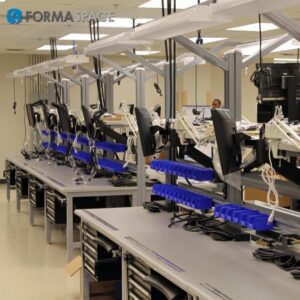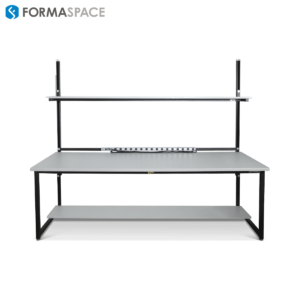Last week for Valentine’s Day, we talked about how we wanted you to fall in love with your workspace all over again. This week will talk about some concrete steps you can take to improve your existing workspace and make it more efficient, comfortable and productive. We think you’ll find these techniques useful whether you work at a home office, in a research laboratory, at a manufacturing facility, educational institution or even in a traditional office setting.
What’s our motivation? Well, as you clean up and organize your existing workspace, it’s quite likely you’ll really begin to determine what your current furniture needs are. This, in turn, may lead you to talk with one of our friendly design specialists about ways you could put some of our efficient furniture solutions to work for you. Let’s get started.
Overview of 5S
Hiroyuki Hirano, a long-time consultant for Toyota, wrote one of the seminal books on the topic: 5 Pillars of the Visual Workplace. In this book, he outlined five stages necessary to establish efficient (or ‘lean’) production. Each of the different stages, or pillars as they are called in the book, begins with an S sound in the original Japanese, hence the term 5S. The five pillars of 5S are:

整理 Seiri (Sort)
Decide what you really need to get the job done, and remove the rest by disposing of it or putting it in storage.
整頓 Seiton (Streamline)
Organize your workspace and tools in a way that each task can flow smoothly into the next one.
清潔 Seiso (Shine)
Keep your workspace and tools tidy and neat.
清潔 Seiketsu (Standardize)
Make uniform procedures for your tasks. This helps others to step in and help when needed or simplifies shift work changeovers.
躾 Shitsuke (Strive)
Try hard to complete these tasks each day.
Take note that while the original names in Japanese are standardized, the translation of each of the five terms into English varies. Here we have used translations from different sources, including articles from Japan Close Up magazine. You may wish to also read Hiroyuki Hirano’s follow up work JIT Implementation Manual – The Complete Guide to Just-In-Time as well as Takashi Osada’s book The 5S’s: Five Keys to a Total Quality Environment. Many organizations have added a sixth S to the list; the most common addition seems to be S for Safety. For example, the EPA has some useful 5S presentations showing how you can incorporate proper material handling and toxic waste disposal procedures as part of 5S. This seems like a worthwhile addition, if you work with materials that require special handling, such as in a laboratory setting or in a factory.
What are the Main Advantages of Implementing 5S Program?
According to Hiroyuki Hirano, three of the primary benefits of 5S include:
1. Zero Changeover Time In a factory setting, 5S helps you reduce the amount of time to switch production from one model to another. A single factory line that can produce multiple products at different times can really help increase profitability of the organization. It reduces capital costs (no need to build a second factory line) while increasing sales by selling different products into more markets at different price points.
2. Zero Defects / Higher Quality The discipline that comes from applying 5S can help reduce errors and establish higher-quality output.
3. Zero Waste Brings Lower Cost If you’ve ever taken an economics course, you know that using capital investment efficiently increases profitability. If you’re wasting materials or ordering duplicate items because you can’t find the original ones, it’s costing you money. The problem is often further compounded because you’re paying for storage, utilities or even taxes to store items that you are not actively using.
To read more about the benefits of 5s, read our article on Kaizen for more information.
But Wait a Minute – I Work in an Office! How Can 5S Help Me?
Hiroyuki Hirano offers an experiment in using 5S principles in an office setting. Each month the IT department was to compile specific performance reports from the company’s enterprise management systems and send them to different departments. As an experiment, the IT Manager decided one month to prepare the reports on time, but not deliver them. Instead, the IT department waited to see which managers noticed something was missing and requested their monthly reports. In this scenario, nearly two thirds of the ‘missing’ reports went unnoticed. The IT manager declared these reports were ‘waste’ and, because they were not used, they didn’t need to produce them any longer.

Asking the ‘5 Why’s’
If you’ve heard about 5S before, you may have also heard the expression “ask the Five Why’s“. The Five Why’s is actually a very straightforward technique for performing what is known as Root Cause Analysis. Let’s look at an example based on the work of Robert B. Pojasek, who wrote the paper “Asking ‘Why?’ Five Times”
1 Why are we using so much cleaning solution? Metal parts need to be cleaned before powder coating. 2 Why do the metal parts need to be cleaned before painting? Metal parts fail quality checks if they are not cleaned before powder coating. 3 Why do the metal parts fail quality checks? The powder coat will not adhere properly to the metal surfaces if they are not cleaned properly. 4 Why do the metal surfaces need to be cleaned? The metal surfaces are contaminated with oil in the storage process. 5 Why do we use oil in the storage process? Oil prevents the metal parts from corroding.
As you can see from the example, at some point you come to a question that makes it difficult to ask the question ‘why?’. This is usually the root cause of the problem, which needs to be studied for possible alternative solutions. Solving this type of problem may reduce waste and increase efficiency by altering or eliminating related steps.
Download Free 5S Red Tag Templates to Help You Get Started
Let’s focus on the first step: Seiri (Sort). During the next 6 weeks, you should identify items that you don’t use and put a red tag on them. You can make your own red tags, or to make it easier for you, we’ve created a free 5S red-tag template, based on standard 5 1/2 – 8 1/2 shipping labels.
Our free template is compatible with any of these Avery products: 15516, 18126, 48126, 48226, 48326, 48330, 5126, 5526, 5783, 8126, 85726, 85783. (Just be sure to print the template at 100% size, with no margin.) Brief everyone on your team about the benefits of putting a red tag on items you rarely or never use. (Just remember, red tagging people is expressly forbidden according to Hiroyuki Hirano!) Then, in six weeks, make an assessment of those items which wear the red tags. If you really don’t need them, consider selling, donating or recycling them.
If you do need them, but not that often, consider putting them into storage. (Don’t forget to talk to us here at Formaspace about custom storage solutions…) In an upcoming article, we’ll talk about what we found when we first performed the Seiri (Sort) step in our warehouse at the Formaspace furniture factory here in Austin, Texas.









